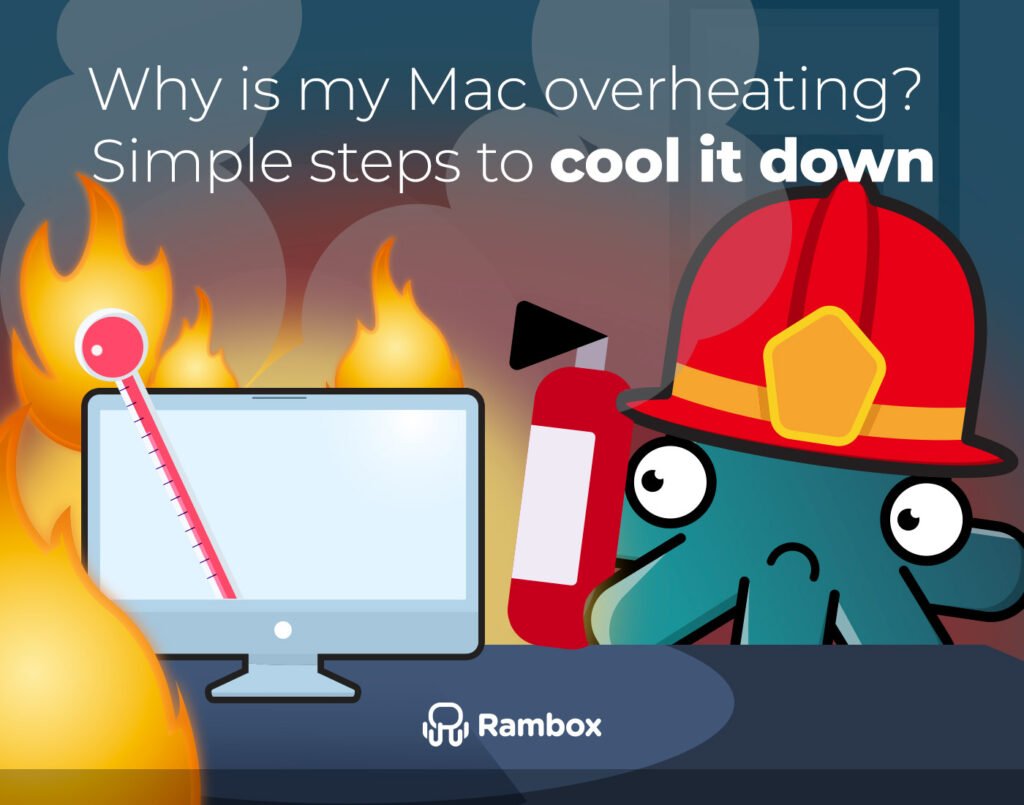Is your Mac running hotter than usual? Overheating can slow down your Mac, cause unexpected shutdowns, and even damage its hardware over time. But don’t worry; you can take plenty of simple steps to cool things down. In this guide, we’ll explore why your Mac might be overheating and walk you through some easy and advanced solutions to help keep your Mac cool and running smoothly.
Let’s get started!
Why is my Mac overheating?
There are several reasons why your Mac might be overheating. By identifying the cause of the overheating, you can take the right steps to cool down your Mac and prevent future issues:
- High CPU usage: When your Mac runs many applications or processes heavy tasks like video editing or gaming, the CPU works harder and generates more heat.
- Poor ventilation: Heat can’t escape appropriately if your Mac’s vents are blocked. Using your Mac on a soft surface like a bed or couch can block the airflow.
- Dust and debris: Over time, dust and debris can accumulate inside your Mac, clogging the fans and vents, reducing airflow, and causing overheating.
- Software issues: Sometimes, a glitch or bug can cause your Mac to overheat. This can include anything from a misbehaving app to outdated software.
- Hardware problems: Faulty hardware components, such as a failing fan or battery, can cause your Mac to overheat.
Simple steps to cool down your Mac
Now that we know some common reasons why your Mac might be overheating, let’s look at some straightforward steps you can take to cool it down. These tips are easy to follow and make a big difference in keeping your Mac running smoothly.
Check CPU usage and quit resource-intensive apps
One of the first steps to cool down your Mac is to check what’s using up all your CPU power. High CPU usage can make your Mac heat up quickly, so it’s important to identify and close any resource-intensive apps. Here’s how you can do it:
- Open Activity monitor: This handy tool is in the Applications > Utilities folder. It shows which apps and processes are consuming the most CPU power.
- Check CPU usage: In Activity Monitor, click on the “CPU” tab to see a list of running applications and their CPU usage. Look for any apps that use a lot of CPUs.
- Quit resource-intensive apps: If you find an app that’s hogging CPU power, select it and click the “X” button in the top-left corner of the window to quit it.
Are the most CPU-intensive applications necessary for your daily tasks?
Have you ever checked which apps use the most CPU on your Mac, only to realize that you need them for your daily tasks? It’s frustrating because you can’t just close or uninstall them without disrupting your workflow. What can you do?
Here’s an awesome solution – Rambox!
Rambox is a great tool that can help reduce the load on your Mac by bringing everything you need into one interface. Its main goal is to eliminate the need to use multiple desktop apps or open various websites in your browser, which can eventually slow down your computer.
Here’s why you should give Rambox a try:
- Efficiency: Rambox can run multiple applications within a single window, reducing your Mac’s CPU strain. For example, running popular apps through Rambox uses around 1500MB of your Mac’s resources compared to 1700MB through Chrome. That’s a solid savings of 11.76%!
CPU consumption in the browser:
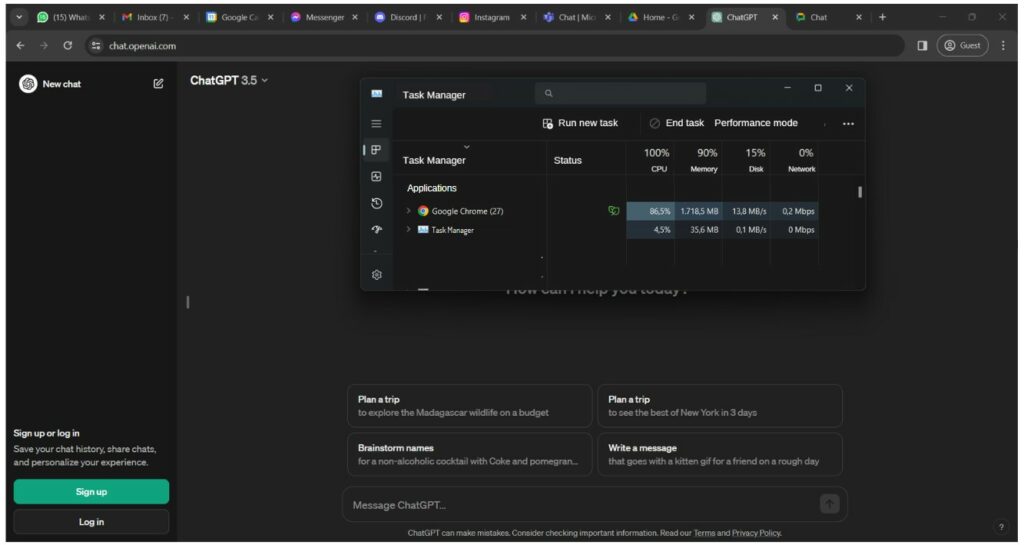
CPU consumption in Rambox:
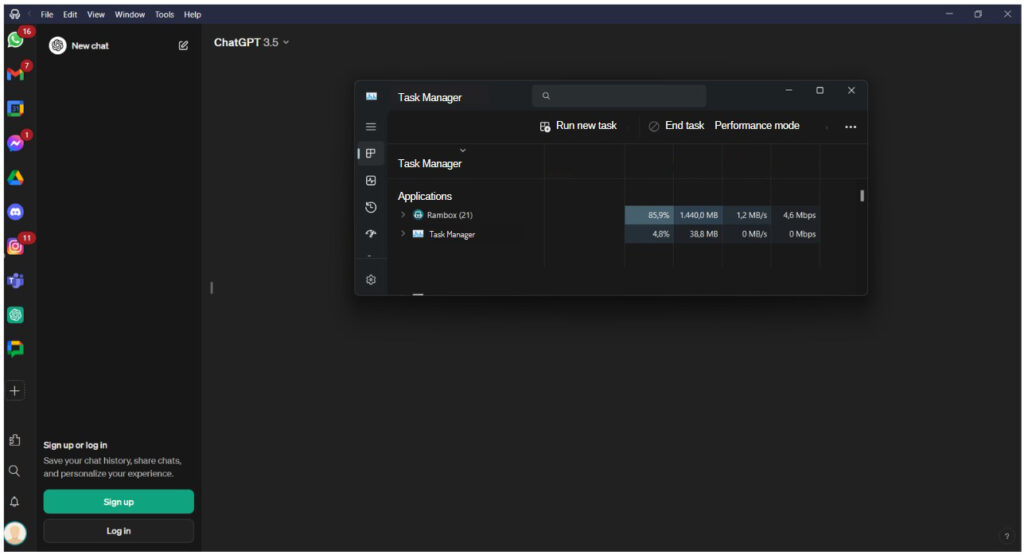
- App Manager: Rambox has a nifty apps manager that shows you exactly how much energy each app uses. You can pause or stop the ones draining too much power. Just open the quick search panel (Alt+Shift+K) and type “apps manager” to find it. It’s easy as pie!

- Quickly Turn Off Apps: Rambox lets you quickly turn off apps you’re not using, which can help save resources. Just right-click on an app and choose “Enabled” to turn it on or off.
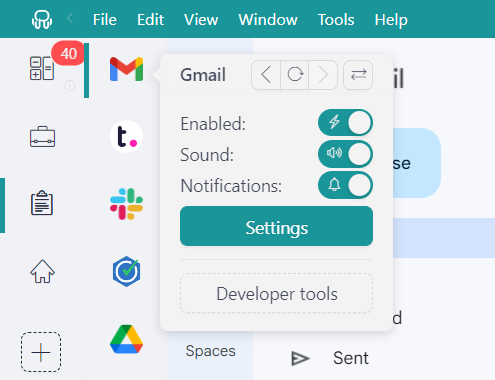
- Hibernation Feature: Rambox has an excellent “Hibernation” feature. It can automatically put apps to sleep after they’ve been inactive for a while, stopping them from using up your computer’s resources in the background. You can set how long an app can be inactive before it goes into hibernation mode. To enable this feature, right-click on the app where you want to set a hibernation time, select “Settings,” and set the time.
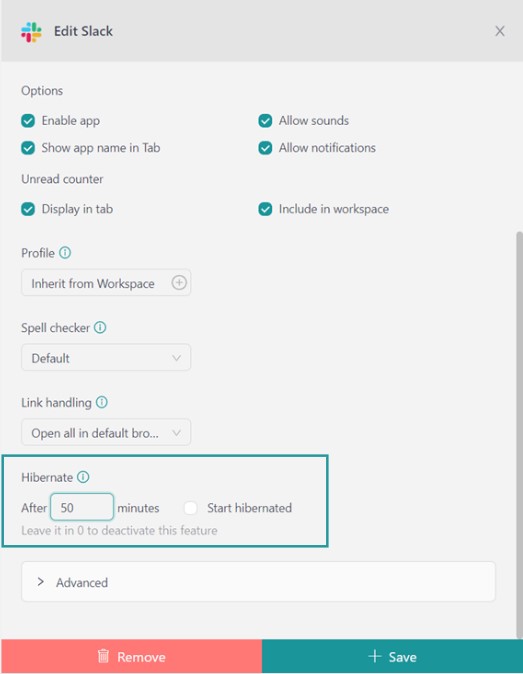
- High CPU Consumption Alerts: If Rambox detects high CPU consumption by an app, it will warn you immediately with a popup message so you can disable, hibernate, or reload the troubling app immediately.
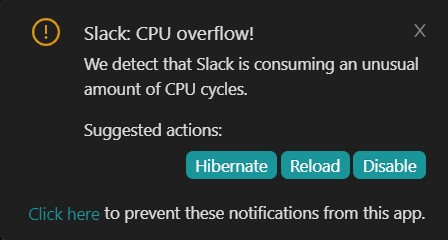
Sounds good, doesn’t it? Try Rambox for free! Just sing up and download the app on Mac to avoid overheating and keep your computer running smoothly.
Use lightweight browsers for Mac
Using lightweight browsers is another effective way to reduce your Mac’s temperature. Some web browsers are notorious for being resource hogs, which can contribute to overheating. Switching to a more efficient browser can help. Here are a few recommendations:
- Safari: Safari is optimized for macOS, making it one of the most efficient browsers for your Mac. It’s designed to work seamlessly with the system, using less CPU and battery power than other browsers.
- Brave: Brave is a privacy-focused browser known for being lightweight. It blocks ads and trackers by default, which can help reduce the load on your CPU.
- Firefox: Firefox has made significant improvements in its performance over the years. It’s a solid alternative that uses less memory and CPU than some more popular browsers.
- Opera: Opera is another browser that’s built to be efficient. It has a built-in ad blocker and various other features that help reduce resource consumption.
Cleaning the fans and vents
Regularly cleaning your Mac’s fans and vents is essential for keeping it cool. Over time, dust and debris can accumulate inside your Mac, clogging the vents and preventing proper airflow. When airflow is restricted, your Mac’s components can overheat.
Here’s how you can clean the fans and vents:
- Power off your Mac: Before cleaning, ensure your Mac is turned off and disconnected from any power source.
- Gather cleaning tools: You’ll need a soft cloth or brush, compressed air (canister or compressor), and possibly a screwdriver (depending on your Mac model).
- External cleaning:
- Wipe down exterior: Use a soft, lint-free cloth lightly dampened with water to wipe down the exterior of your Mac. Avoid getting moisture in any openings.
- Clean vents: Use compressed air to blow out dust and debris from the vents. Hold the canister upright and use short bursts to avoid moisture buildup. You can also use a small, soft brush to loosen stubborn dust.
- Internal cleaning (Advanced):
- Open your Mac: If you’re comfortable and your warranty allows, consider opening your Mac to access the internal components.
- Clean fans and heat sink: Use compressed air to blow out dust from the fans and heat sink carefully. Be gentle to avoid damaging any components.
- Reassemble and test: After cleaning, reassemble your Mac (if opened) and power it on to ensure everything functions properly. Monitor the temperature to see if cleaning has improved cooling efficiency.
Updating macOS and software
Keeping your macOS and software up to date is crucial for maintaining your Mac’s performance and preventing overheating issues. Updates often include bug fixes, security patches, and performance improvements that can optimize your system’s efficiency. Here’s how to ensure your Mac stays updated:
Check for macOS updates
- Apple menu: Click on the Apple logo in the top-left corner of your screen and select “System Preferences.”
- Software update: In the System Preferences window, click “Software Update.” Your Mac will automatically check for available updates. If updates are available, click “Update Now” to install them.
Update third-party apps
- App store: Open the App Store on your Mac.
- Updates tab: Click the “Updates” tab in the App Store toolbar. Here, you’ll see a list of apps that have updates available.
- Update all: Click “Update All” to install all available updates, or click “Update” next to individual apps to update them selectively.
Enable automatic updates
You can enable automatic updates in the “Software Update” section of System Preferences. Your Mac will then download and install updates in the background, ensuring you’re always up to date without manual intervention.
Advanced solutions
If these simple tips haven’t resolved your Mac’s overheating issue, don’t worry. Here are some more advanced solutions to consider. Please proceed with caution, as these steps involve more technical adjustments.
Resetting the SMC (System Management Controller)
Resetting the SMC can resolve various hardware-related issues, including overheating problems. Here’s how to do it:
- Shut down your Mac: Completely turn off your Mac.
- SMC reset (Different Methods Depending on Mac Model):
- MacBook with non-removable battery: Press and hold Shift + Control + Option on the left side of the built-in keyboard, then press the power button simultaneously. Hold all keys and the power button for 10 seconds. Release all keys, then press the power button again to turn on your Mac.
- MacBook with removable battery: Shut down your Mac. Disconnect the power adapter, then remove the battery. Press and hold the power button for 5 seconds. Reinstall the battery, reconnect the power adapter, and turn on your Mac.
- Desktop Mac (iMac, Mac Pro, Mac Mini): Shut down your Mac. Unplug the power cord for 15 seconds. Plug the power cord back in and wait 5 seconds, then turn on your Mac.
- Check for improvement: After resetting the SMC, monitor your Mac to see if the overheating issue persists.
Adjusting energy settings
Adjusting your Mac’s energy settings can help reduce power consumption and heat generation. Here’s how to optimize them:
- System Preferences: Click on the Apple menu, then select “System Preferences.”
- Energy Saver: Click “Energy Saver” to access settings controlling how your Mac uses power.
- Adjust settings:
- Turn off the display: Set a shorter time before the display goes to sleep.
- Put hard disks to sleep: Enable this option to conserve energy when disks are idle.
- Enable Power Nap: This allows your Mac to perform software updates and backups while asleep.
- Save changes: Adjust according to your preferences and click “Save” to apply changes.
Reapplying thermal paste
Over time, the thermal paste between your Mac’s CPU and heat sink can dry out or degrade, reducing its effectiveness in transferring heat. Here’s how to reapply thermal paste:
- Prepare your workspace: Turn off your Mac and place it on a soft, static-free surface.
- Access the CPU: Depending on your Mac model, you may need to open the casing to access the CPU and heat sink.
- Clean old paste: Use isopropyl alcohol and a lint-free cloth or cotton swab to carefully clean off the old thermal paste from the CPU and heat sink.
- Apply new thermal paste: Apply a small, pea-sized amount of new thermal paste to the center of the CPU. Carefully reinstall the heat sink and ensure it’s securely fastened.
- Test your Mac: Power on your Mac and monitor its temperature to see if reapplying thermal paste has improved cooling performance.
Now that you know why your Mac may be overheating, we hope our tips for keeping it cool have helped.
Remember to use Rambox to avoid high CPU consumption and prevent your Mac from getting hotter than an oven again!
